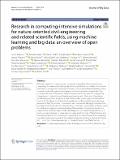| dc.contributor.author | Babović, Zoran | |
| dc.contributor.author | Bajat, Branislav | |
| dc.contributor.author | Đokić, Vladan | |
| dc.contributor.author | Đorđević, Filip | |
| dc.contributor.author | Drašković, Dražen | |
| dc.contributor.author | Filipović, Nenad | |
| dc.contributor.author | Furht, Borko | |
| dc.contributor.author | Gačić, Nikola | |
| dc.contributor.author | Ikodinović, Igor | |
| dc.contributor.author | Ilić, Marija | |
| dc.contributor.author | Irfanoglu, Ayhan | |
| dc.contributor.author | Jelenković, Branislav | |
| dc.contributor.author | Kartelj, Aleksandar | |
| dc.contributor.author | Klimeck, Gerhard | |
| dc.contributor.author | Korolija, Nenad | |
| dc.date.accessioned | 2023-05-30T16:34:24Z | |
| dc.date.available | 2023-05-30T16:34:24Z | |
| dc.date.issued | 2023-05-22 | |
| dc.identifier.uri | https://hdl.handle.net/1721.1/150828 | |
| dc.description.abstract | Abstract
This article presents a taxonomy and represents a repository of open problems in computing for numerically and logically intensive problems in a number of disciplines that have to synergize for the best performance of simulation-based feasibility studies on nature-oriented engineering in general and civil engineering in particular. Topics include but are not limited to: Nature-based construction, genomics supporting nature-based construction, earthquake engineering, and other types of geophysical disaster prevention activities, as well as the studies of processes and materials of interest for the above. In all these fields, problems are discussed that generate huge amounts of Big Data and are characterized with mathematically highly complex Iterative Algorithms. In the domain of applications, it has been stressed that problems could be made less computationally demanding if the number of computing iterations is made smaller (with the help of Artificial Intelligence or Conditional Algorithms), or if each computing iteration is made shorter in time (with the help of Data Filtration and Data Quantization). In the domain of computing, it has been stressed that computing could be made more powerful if the implementation technology is changed (Si, GaAs, etc.…), or if the computing paradigm is changed (Control Flow, Data Flow, etc.…). | en_US |
| dc.publisher | Springer International Publishing | en_US |
| dc.relation.isversionof | https://doi.org/10.1186/s40537-023-00731-6 | en_US |
| dc.rights | Creative Commons Attribution | en_US |
| dc.rights.uri | http://creativecommons.org/licenses/by/4.0/ | en_US |
| dc.source | Springer International Publishing | en_US |
| dc.title | Research in computing-intensive simulations for nature-oriented civil-engineering and related scientific fields, using machine learning and big data: an overview of open problems | en_US |
| dc.type | Article | en_US |
| dc.identifier.citation | Journal of Big Data. 2023 May 22;10(1):73 | en_US |
| dc.contributor.department | Massachusetts Institute of Technology. Institute for Data, Systems, and Society | |
| dc.identifier.mitlicense | PUBLISHER_CC | |
| dc.eprint.version | Final published version | en_US |
| dc.type.uri | http://purl.org/eprint/type/JournalArticle | en_US |
| eprint.status | http://purl.org/eprint/status/PeerReviewed | en_US |
| dc.date.updated | 2023-05-28T03:14:24Z | |
| dc.language.rfc3066 | en | |
| dc.rights.holder | The Author(s) | |
| dspace.embargo.terms | N | |
| dspace.date.submission | 2023-05-28T03:14:24Z | |
| mit.license | PUBLISHER_CC | |
| mit.metadata.status | Authority Work and Publication Information Needed | en_US |
